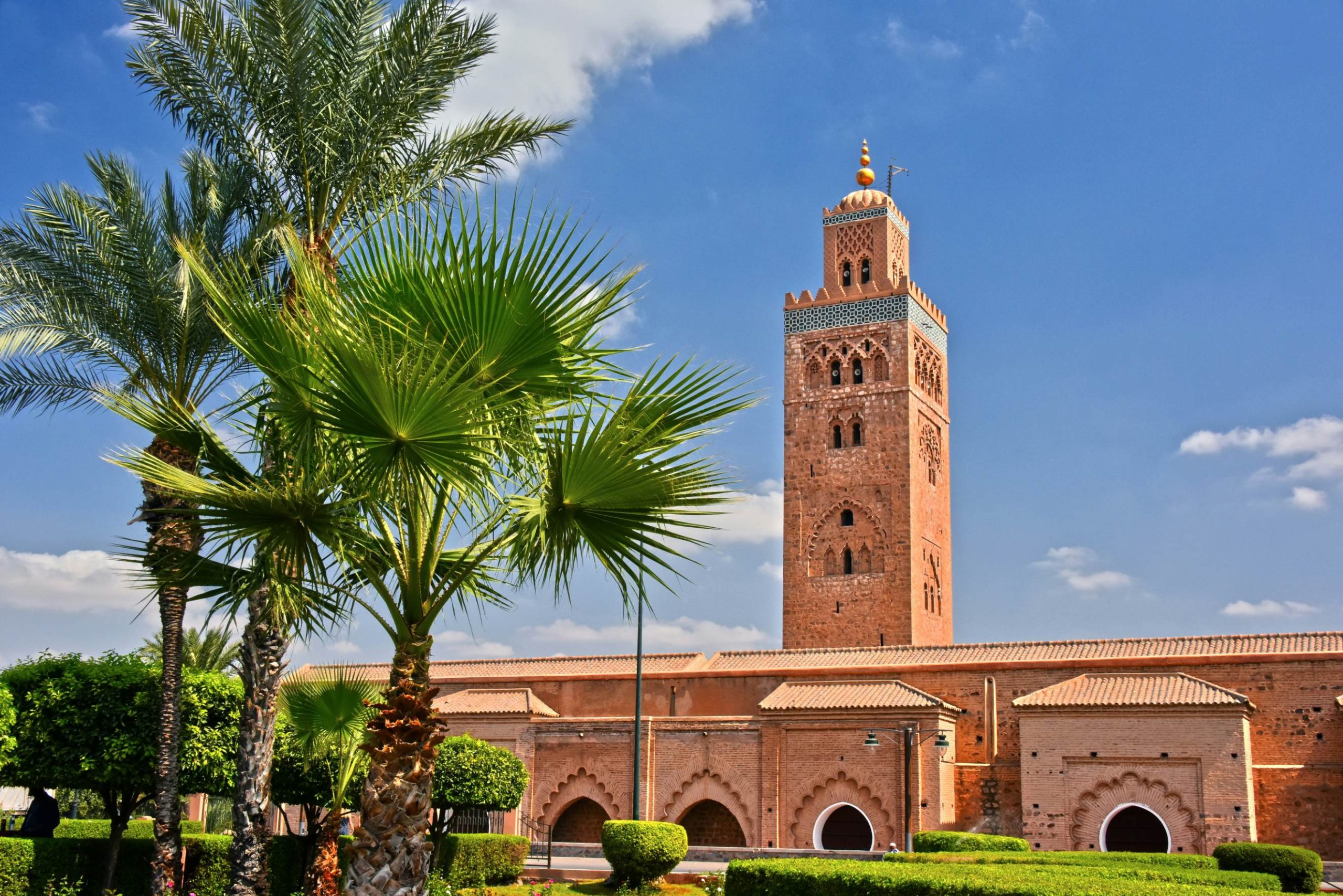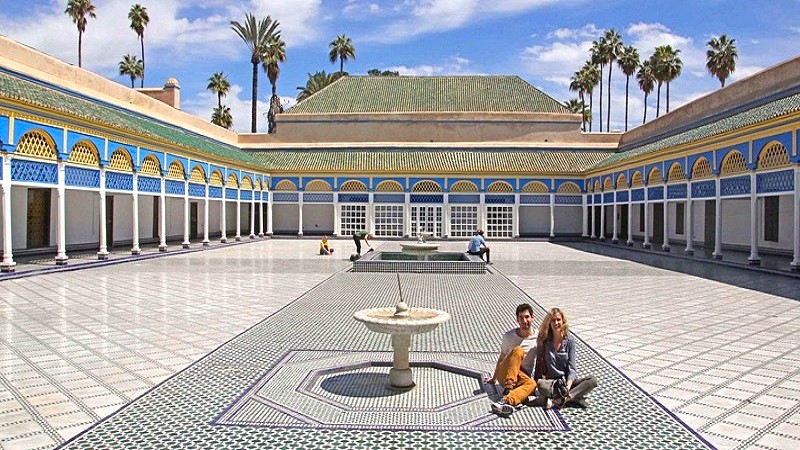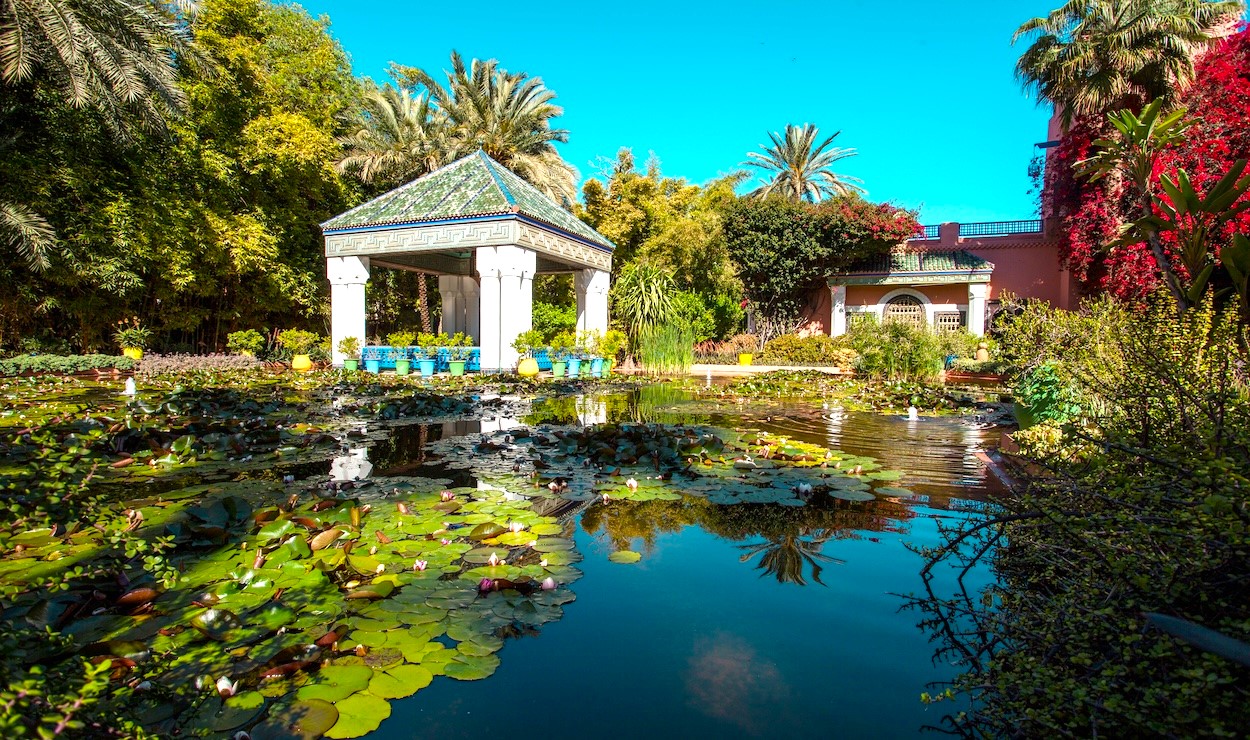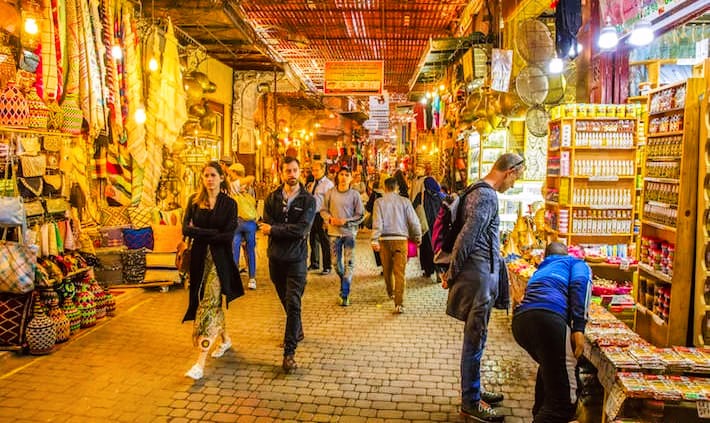Historic Monuments of Marrakech: The Red City’s Living Legacy
Few cities on Earth ignite the imagination quite like Marrakech. Known as the Red City for its sun-baked walls and rose-tinted ramparts, this imperial gem has stood for nearly a thousand years as a crossroads of power, faith, and artistry. The pulse of Morocco beats strongest here, in the call of muezzins echoing from ancient minarets, the rustle of silk in the bustling souks, and the golden light that washes over its legendary monuments at dusk.
Founded in the 11th century by the Almoravid dynasty, Marrakech quickly became a symbol of empire and a center for trade, architecture, and learning. Its monuments, from the towering Koutoubia Mosque to the serene Saadian Tombs, reflect not only Morocco’s Islamic heritage but also centuries of artistic evolution. Every gate, courtyard, and minaret tells a story of ambition, devotion, and timeless beauty.
But Marrakech is more than a collection of monuments; it’s a living city, where history breathes through every archway and garden. Here, the past is not frozen; it dances in the rhythm of the Jemaa el-Fna square, it whispers in the cool halls of the Bahia Palace, and it lingers in the fragrance of orange blossoms drifting through the old medina.
For travelers tracing Morocco’s imperial heritage, exploring the historic monuments of Marrakech is a journey into the very heart of North African civilization, a bridge between ancient dynasties and the vibrant culture that endures today.
If you’re planning to explore all of Morocco’s Imperial Cities or seeking a deeper insight into their architectural wonders, Marrakech is the perfect place to begin.
The Birth of Marrakech and Its Royal Foundations
The story of Marrakech begins in the mid-11th century, when the Almoravid dynasty founded it as a desert fortress and trading post. What started as a modest military outpost soon blossomed into the beating heart of an empire that stretched across North Africa and southern Spain. Its founders, the Berber Almoravids, envisioned a city that would unite commerce, faith, and culture under one roof.
By the 12th century, Marrakech had already established itself as a royal capital, rivaling Fes in influence and prestige. Under the rule of Yusuf ibn Tashfin, the city flourished with grand mosques, gardens, and palaces that symbolized both political power and spiritual devotion. It was during this golden era that the first version of the Koutoubia Mosque, Marrakech’s most iconic monument, was constructed.
The Almoravids also laid the foundations for the city’s Medina, which still stands today as a labyrinth of history and daily life. Recognized by UNESCO as a World Heritage Site, the Medina of Marrakech remains one of the most vibrant and best-preserved medieval cities in the Islamic world. Wandering through its gates, visitors can almost hear the echo of camel caravans arriving from the Sahara, bringing gold, salt, and stories from distant lands.
When the Almohads succeeded the Almoravids in the 12th century, they expanded Marrakech even further, transforming it into a beacon of faith and architecture. Their influence is visible in many of the city’s enduring monuments, including the Koutoubia Mosque, whose graceful minaret would later inspire the design of the Giralda of Seville and the Hassan Tower of Rabat.
For travelers following the trail of Morocco’s imperial cities, Marrakech represents the meeting point between desert mystique and royal grandeur, where each stone tells the story of a civilization that dared to dream in red.

The Koutoubia Mosque: Symbol of Marrakech’s Faith and Artistry
No monument defines the skyline of Marrakech quite like the Koutoubia Mosque, the city’s spiritual and architectural masterpiece. Rising nearly 70 meters high, its elegant minaret can be seen from miles away, guiding travelers toward the heart of the Red City.
Built during the reign of the Almohad dynasty in the 12th century, the Koutoubia Mosque stands as one of the most important monuments in Islamic architecture. It was commissioned by Caliph Yaqub al-Mansur, who envisioned a mosque that would embody the unity of faith and art. Its name, Koutoubia, comes from the Arabic word kutubiyyin meaning “booksellers,” since it once stood beside a bustling market filled with merchants trading manuscripts and sacred texts.
The mosque’s design reflects the mastery of Almohad architecture — characterized by graceful arches, geometric ornamentation, and harmonious proportions. Its minaret, adorned with intricate stonework and topped with four golden orbs, later inspired other monumental towers across the Islamic world, such as the Giralda of Seville in Spain and the Hassan Tower of Rabat.
Inside, the prayer hall is vast and serene, supported by a forest of columns that create a rhythm of light and shadow. Though non-Muslim visitors cannot enter the mosque itself, they can admire its beauty from the surrounding Koutoubia Gardens, a peaceful refuge scented with roses and orange blossoms.
Today, the Koutoubia remains not only a functioning mosque but also a symbol of Marrakech’s soul, a bridge between heaven and earth, past and present. Its call to prayer continues to echo across the city, just as it has for more than eight centuries, reminding all who hear it that Marrakech is a city built upon faith, art, and endurance.
For those exploring Morocco’s Imperial Cities, the Koutoubia Mosque is more than an architectural wonder, it is a living monument to the devotion and craftsmanship that define Morocco’s spiritual heritage.

The Palaces of Power: Bahia and El Badi
Marrakech’s grandeur extends far beyond its mosques and medina streets into the sumptuous palaces that once housed sultans, courtiers, and royal artisans. Among the most iconic are the Bahia Palace and the El Badi Palace, each reflecting the city’s imperial past and the artistic vision of Morocco’s dynasties.
Bahia Palace: A Jewel of 19TH-CENTURY Craftsmanship
Constructed in the late 19th century by Si Moussa, the grand vizier of Sultan Hassan I, the Bahia Palace was designed to be the most beautiful palace of its time, both in scale and artistry. Its name, Bahia, means “brilliance,” and the palace lives up to it with exquisite zellige tilework, carved cedar ceilings, and serene inner courtyards adorned with fountains and orange trees.
Visitors wandering through its labyrinthine halls and tranquil gardens can sense the meticulous planning and craftsmanship that went into every detail. The palace was built to host the royal family and to impress foreign dignitaries, making it both a private retreat and a symbol of Marrakech’s political and cultural sophistication.
El Badi Palace: A Monument to Ambition and Splendor
In contrast, the El Badi Palace represents ambition and grandeur on a monumental scale. Commissioned in the late 16th century by Sultan Ahmad al-Mansur of the Saadian dynasty, the palace was adorned with gold, onyx, marble, and intricate mosaics. It was designed as a testament to Morocco’s wealth, especially following the victory over the Portuguese at the Battle of the Three Kings.
Though largely in ruins today, the vast courtyards, sunken gardens, and towering walls still convey the scale of its former glory. The palace grounds also host occasional cultural events, linking Marrakech’s imperial past with its living artistic present. From the terraces, visitors enjoy sweeping views of the Atlas Mountains and the bustling medina, connecting the city’s history to the natural beauty that surrounds it.
A Window into Imperial Life
Together, Bahia and El Badi palaces provide a glimpse into the lives of Marrakech’s rulers, the grandeur of their courts, and the artisans’ mastery in every carved ceiling, tiled wall, and painted corridor. They remind travelers that Marrakech’s historic monuments are not just relics; they are stories carved in stone, tile, and cedar, testimonies to centuries of power, artistry, and vision.
Exploring these palaces is an essential step in understanding Marrakech’s role within Morocco’s imperial cities, highlighting the city’s unique combination of political significance and cultural brilliance.

The Gardens and Tombs of Marrakech
Beyond the bustling streets and grand palaces, Marrakech reveals another side of its historic charm through its serene gardens and royal tombs. These spaces offer travelers a chance to pause, reflect, and appreciate the city’s blend of nature, history, and spiritual significance.
The Majorelle Garden: A Modern Oasis with Historical Roots
Perhaps the most famous garden in Marrakech is the Majorelle Garden, designed by French painter Jacques Majorelle in the early 20th century. Although a more modern creation compared to ancient monuments, it sits on land that resonates with Moroccan artistic tradition. The garden is renowned for its vivid cobalt blue accents, exotic plants, and tranquil fountains, offering a peaceful escape from the vibrant medina.
Purchased and restored by fashion designer Yves Saint Laurent, the Majorelle Garden now also houses the Berber Museum, which showcases Amazigh culture, linking visitors to the broader heritage of Morocco’s imperial cities. It’s a must-visit destination for anyone exploring the historic monuments of Marrakech.
Saadian Tombs: A Glimpse into Royal History
For travelers interested in royal history, the Saadian Tombs provide a fascinating insight. Built in the 16th century under Sultan Ahmad al-Mansur, these tombs were rediscovered in 1917 after being hidden for centuries. The site contains the graves of more than sixty members of the Saadian dynasty, including soldiers, courtiers, and sultans.
The tombs’ architecture is a masterpiece of Moroccan design, with intricate stucco work, mosaic floors, and finely carved cedar wood. Visiting the Saadian Tombs allows travelers to appreciate the luxury and artistry of Morocco’s royal courts while understanding the city’s historical depth.
Menara Gardens: Reflection and Tranquility
Another emblematic garden is the Menara Gardens, dating back to the 12th century. Situated at the foot of the Atlas Mountains, the gardens feature a large reflecting pool surrounded by olive groves and the iconic pavilion. Originally built as a royal orchard and leisure space, the Menara Gardens remain a peaceful retreat for locals and travelers alike.
The reflection of the Atlas Mountains in the pool, combined with the shade of centuries-old olive trees, creates a picture-perfect scene that captures Marrakech’s timeless beauty. It’s a reminder that the city’s historic monuments are not only about stone and tile but also about the natural landscapes that frame them.
Connecting History and Nature
The gardens and tombs of Marrakech demonstrate how history, architecture, and nature intertwine to form a city unlike any other. They provide a serene counterpoint to the bustling medina, allowing travelers to connect with both the imperial grandeur and the spiritual essence of Marrakech.
For visitors exploring Morocco’s imperial cities, these spaces are essential stops, offering both beauty and insight into the city’s centuries-old traditions.

The Artisan Quarters and Souks of Marrakech
Marrakech is a city of vivid colors, sounds, and smells, and nowhere is this more evident than in its artisan quarters and souks. These bustling markets are not only a hub for trade but also a living museum of Moroccan craftsmanship, where centuries-old techniques are practiced daily.
The Souks of the Medina: A Labyrinth of Tradition
The Medina of Marrakech is home to some of the most famous souks in Morocco, each specializing in a particular craft. From Souk Smarine, where leather goods are dyed and stitched, to Souk Haddadine, the home of metalworkers shaping lanterns and trays, every alleyway offers a glimpse into the artisanal heritage of the city.
Walking through these winding streets, travelers can witness artisans crafting zellige tiles, carved wooden doors, and traditional textiles by hand. The skill, precision, and patience of the craftsmen connect visitors to the living history of Marrakech, a tradition that has endured for centuries.
The Tanneries: Preserving an Ancient Craft
Similar to Fes, Marrakech also boasts historic tanneries, where leather is dyed using natural pigments. These tanneries, located near the Bab Debbagh area, offer a unique sensory experience. Visitors can view the vibrant dyeing pits from rooftops while learning about the traditional techniques that have been preserved over generations.
The tanneries serve as a reminder of Morocco’s deep-rooted artisanal culture, linking the modern city to its imperial past. They also highlight Marrakech’s role as a commercial hub, historically connecting the Saharan trade routes with Mediterranean markets.
Cooperative Workshops: Supporting Local Artisans
In addition to the souks, Marrakech hosts artisan cooperatives, where visitors can watch pottery, embroidery, and metalwork being created while supporting local craftsmen. Many of these cooperatives emphasize sustainable and traditional practices, ensuring that Morocco’s rich artisanal heritage continues to thrive in the modern era.
Experiencing Marrakech Through Its Crafts
Exploring the artisan quarters allows travelers to immerse themselves in the sights, sounds, and stories of Marrakech. It’s a reminder that the city’s historic monuments are not just buildings; they are part of a living ecosystem of trade, culture, and creativity. Each piece of handcrafted art tells a story, whether it’s a handwoven carpet, a carved wooden door, or a mosaic in the Koutoubia Mosque.
For those planning to explore all Morocco’s imperial cities, visiting the artisan quarters of Marrakech is essential to understanding the city’s cultural and economic heartbeat.
Discover The Historic Monuments of Marrakech !
Let our local experts at Holiday Morocco Tours help you design a journey that brings the city’s living heritage to life. From curated palace visits to immersive medina tours, we ensure that your Moroccan adventure is as unforgettable and authentic as the city itself.
Don’t just read about Morocco’s imperial cities! experience their magic firsthand!
Preservation and Living Heritage of Marrakech
Marrakech is not just a city frozen in time; it is a living, breathing testament to centuries of Moroccan history, art, and culture. Its historic monuments, bustling souks, and artisan workshops are actively preserved, ensuring that the city’s imperial legacy continues to inspire travelers and locals alike.
UNESCO Recognition and Restoration Efforts
The Medina of Marrakech was recognized by UNESCO as a World Heritage Site in 1985, highlighting its exceptional universal value. The organization emphasizes the Medina’s urban layout, historic monuments, and traditional crafts, which provide insight into Morocco’s imperial past.
Restoration projects, often led by UNESCO and the Moroccan Ministry of Culture, focus on key sites such as the Koutoubia Mosque, Bahia Palace, and Saadian Tombs. These initiatives not only protect the city’s architectural treasures but also support local artisans in maintaining traditional techniques like zellige tilework, carved stucco, and cedar wood craftsmanship.
A City That Lives and Breathes
Unlike many historical sites that feel static, Marrakech thrives as a living city, where history and modern life coexist. Markets hum with activity, artisans continue centuries-old trades, and the rhythms of daily life echo through the ancient medina streets. This dynamic heritage ensures that visitors experience the city not as a museum, but as a vibrant, ongoing story of Moroccan culture.
Cultural Festivals and Traditions
Marrakech celebrates its history through numerous cultural festivals. The Marrakech International Film Festival and traditional events in the medina highlight both Morocco’s contemporary creativity and its imperial legacy. Local artisans, musicians, and performers actively contribute, keeping ancient crafts, music, and ceremonial traditions alive for future generations.
Heritage for the Future
Preserving Marrakech is about more than monuments; it is about maintaining a way of life. Restoration projects and artisan initiatives focus on empowering local communities, passing traditional skills to younger generations, and revitalizing neighborhoods within the Medina. This ensures that Marrakech remains not only an architectural marvel but also a city of living culture, where every alleyway, fountain, and garden continues to tell a story.
For travelers seeking to explore Morocco’s imperial cities, Marrakech exemplifies how a city can honor its historic monuments while remaining vibrant, modern, and deeply connected to its roots.
Experience the Living Legacy of Marrakech
Exploring Marrakech is like stepping into a living history book, where every monument, garden, and artisan workshop tells a story of royal ambition, spiritual devotion, and creative mastery. From the soaring minaret of the Koutoubia Mosque to the serene courtyards of the Bahia Palace, the city offers travelers a unique journey through time, art, and culture.
Marrakech is not only a city to observe but one to immerse yourself in. Wander its bustling Medina, marvel at the centuries-old craftsmanship in the souks, and stroll through tranquil gardens like the Majorelle Garden or Menara Gardens, where history and nature intertwine. Every corner of the Red City invites curiosity, reflection, and inspiration.
